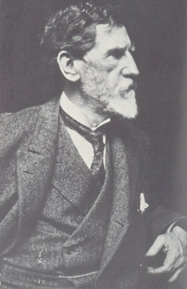Sarah LuriaAssociate Professor, Department of English |
Augustus Saint-Gaudens (1848-1907)
Augustus Saint-Gaudens was once considered the most important American sculptor of the 19th century for several reasons: he put American sculpture on the map and gave it an identity separate from Europe; through his commitment to education, he made it possible for American artists to be schooled in the United States rather than having to go to Europe for their training, as he had had to do; he redefined commemorative sculpture as a dynamic form; and he was the first to pay close attention to the setting of his works. Saint-Gaudens insured the success of his career early on with his Farragut Monument--a sculpture of David Farragut, the Civil War naval officer who led the capture of New Orleans in 1862, and who became the first admiral of the U.S. Navy. Monuments such as these were typically static and had little connection to their surroundings, but Saint-Gaudens' monument changed all that. His statue was full of life and movement. (Later he would create another monument--his Standing Lincoln (1887)--in which Lincoln is shown having just gotten up from his chair.) To design the most effective setting for his sculptures, Saint-Gaudens formed an innovative collaboration with the architects Stanford White and Charles Follen McKim, and their firm McKim, Mead, and White. Working with McKim and White, Saint-Gaudens designed environments that created a small world around his sculptures. His Farragut Monument, for example, is described by one biographer thus:
The Farragut Monument was "unparalleled in American sculpture" and set a new standard. It was hailed as the "beginning of an American Renaissance" ("Saint Gaudens" American National Biography (New York, 1999), 199). It is interesting to compare it to the later Shaw Memorial (1897). The Shaw Memorial was one of several Civil War Monuments that were commissioned from Saint-Gaudens. (His last was the General Sherman Led by Lady Victory (1903) located at 59th St. and Central Park in New York.) It draws from Saint-Gaudens intense interest in reliefs, another form which he re-defined. Prior to his work, reliefs were often simply busts sliced in half and placed on a plain background. The Shaw Memorial is an extremely "subtly drawn" "history painting" that comes to life as Shaw and his men march by; it ingeniously incorporates 3-D sculpture with relief work. Saint-Gaudens interest in reliefs may have drawn upon his early experience as a cameo cutter, an art form he learned at age 13, and by which he supported himself during his apprenticeship as a sculptor. Saint-Gaudens would again draw upon this training and interest as he revived the form of coin design and created the Liberty Quarter under President Theodore Roosevelt. One last point of contact between Saint-Gaudens' career and Lowell's poem: Saint-Gaudens was part of a highly influential circle of artists during the end of the 19th century including McKim and White, and architect H. H. Richardson, stained glass artist John La Farge, and historian Henry Adams. These men were friends and advisors to presidents and other high-level authorities. Together they revived what they saw as a refined collaboration between morality, politics, and the arts to challenge the corruption of government that so signaled their era--an era which Mark Twain dubbed The Gilded Age. The Gilded Age was the post-War era when people got immensely rich (this was the age of Carnegie, Mellon, and the Vanderbilts) and lost what some believed was the idealism and high-mindedness that at moments characterized the Civil War and even Reconstruction. During the first half of the 20th century Saint-Gaudens receded from public notice, obscured by the new interests and aesthetics of modernism. He has recently, however, been restored to his former status as premier sculptor of the 19th century. Source: "Saint Gaudens" American National Biography (New York, 1999), 198-201. Photo Source: Saint-Gaudens National Historic Site.
|
